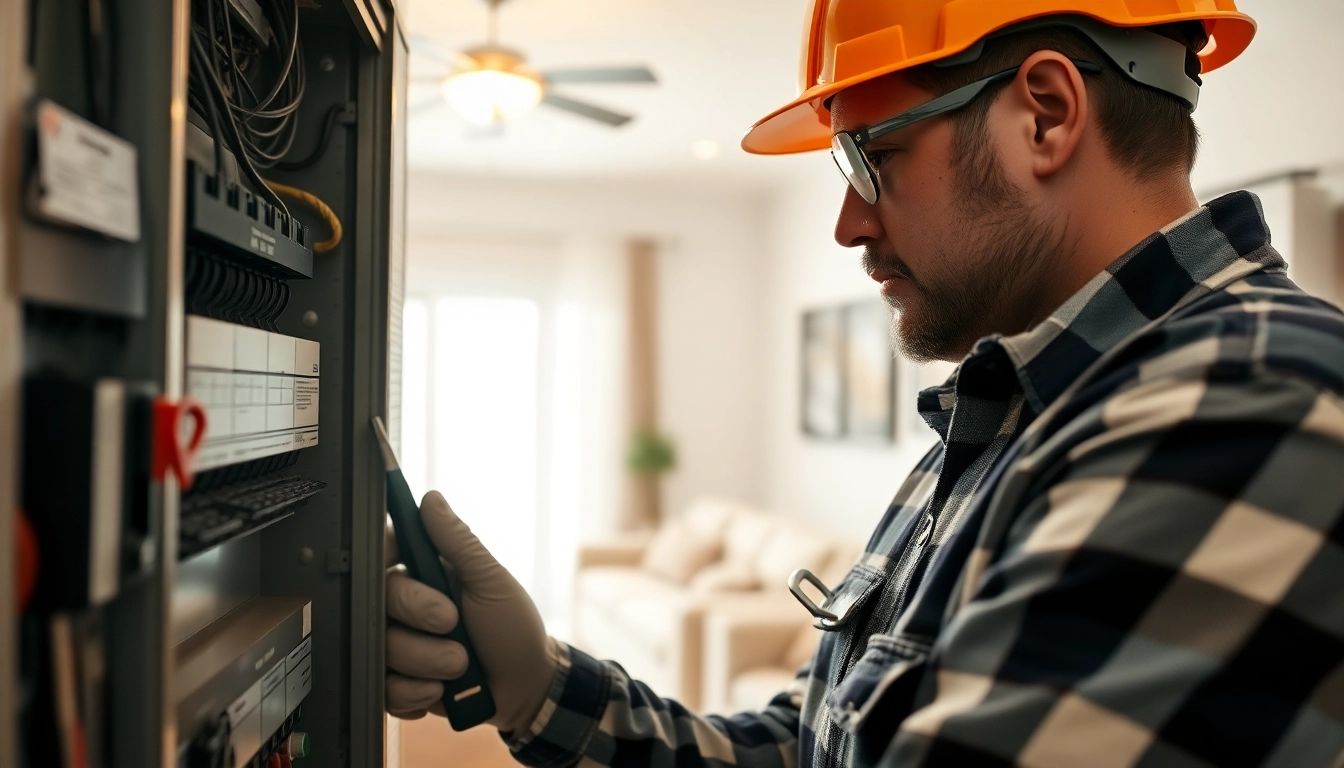
Understanding the Need for an Electrical Panel Upgrade
In an age where our reliance on electricity continues to grow, ensuring that our home’s electrical systems can meet modern demands is crucial. One significant upgrade many homeowners face is upgrading their electrical panel. This process allows for greater capacity and improved safety, accommodating the evolving needs of home technology. Recognizing the signs that point towards the need for an Electrical Panel Upgrade can help prevent potential hazards and enhance the efficiency of your electrical system.
Signs You Need an Electrical Panel Upgrade
The need for an upgrade often presents itself through several telltale indicators:
- Frequent Tripped Breakers: If your breakers trip often during normal use, it’s a strong sign that your panel is overloaded.
- Older Panel Types: Homes with obsolete panels, such as FPE or Zinsco, are potential fire hazards and should be replaced.
- Inconsistent Power: Dimming lights, especially when appliances kick on, indicate that your system is struggling to meet the demand.
- Renovations and Additions: Changes in your home, like additional rooms or electric vehicle chargers, may exceed the existing panel’s capacity.
- Electrical Fires: Discoloration or a burning smell near the panel point to imminent danger and the need for immediate intervention.
Benefits of an Electrical Panel Upgrade
Upgrading your electrical panel not only resolves the issues above but brings numerous benefits, including:
- Increased Capacity: A modern panel can provide higher amperage, accommodating more devices and reducing the risk of overload.
- Improved Safety: Newer panels have advanced safety features that minimize hazards and are compliant with current electrical codes.
- Enhanced Property Value: A home with a modern electrical system becomes more attractive to potential buyers and can command a higher price.
- Future-Proofing: Upgraded systems allow homeowners to install new technologies without worrying about electrical limitations.
Common Misconceptions about Electrical Panel Upgrades
Several myths surround electrical panel upgrades that can mislead homeowners:
- Myth: Only New Homes Need Upgrades: Reality: Homes of any age can benefit from an upgrade, especially if they’ve undergone renovations.
- Myth: Upgrades Are Only Necessary for Increased Usage: Reality: Even if usage hasn’t changed, older panels can be inefficient and dangerous.
- Myth: All Electrical Work Requires Major Overhauls: Reality: Many upgrades can be done without extensive renovations, focusing only on the panel.
Evaluating Your Current Electrical System
Understanding your electrical system is the first step in determining if an upgrade is necessary. This involves a comprehensive assessment of your existing setup.
How to Assess Your Electrical Panel’s Capacity
Checking your electrical panel’s capacity involves knowing your home’s current setup:
- Locate your main circuit panel and check the label for amperage rating.
- Count the number of breakers and their respective amperages to gauge your total electrical load.
- If your panel is rated below 200 amps and you have high demands (like multiple large appliances or a home office), upgrading may be necessary.
Identifying Outdated Wiring and Components
Identifying outdated wiring is critical for safety and efficiency:
- Inspect wiring for wear and tear, including fraying or discoloration.
- Check for aluminum wiring, common in older homes, which has safety concerns compared to modern copper wiring.
- Ensure that your grounding systems are up to code, as improper grounding is a prevalent cause of electrical fires.
Safety Concerns Related to Old Electrical Panels
Old electrical panels can pose numerous safety hazards:
- Risk of Fire: As components age, they may fail, leading to electrical fires.
- Shock Hazards: Deteriorated insulation can pose shock risks when appliances are operated.
- Outdated Safety Features: Older panels lack current safety features, increasing the likelihood of system failures.
Types of Electrical Panels and Their Capacities
Understanding the different types of electrical panels and their capacities is essential for choosing the right one for your home.
Standard Residential Panels Explained
Most homes use standard residential panels, which come in various sizes:
- 100-Amp Panels: Suitable for smaller homes with limited power needs. They may not support modern load requirements.
- 200-Amp Panels: Ideal for average-sized homes, they accommodate higher power demands and are often required for larger appliances and systems.
- 400-Amp Panels: Typically found in larger homes or those with unique power requirements, such as home offices or multiple large appliances.
Comparing 100A vs. 200A Panels
The comparison between 100A and 200A panels reveals significant differences:
- Homes with a 100A panel may experience overload issues as more devices are added.
- 200A panels support larger loads, making them more suitable for modern living, including electric vehicles and home technology.
- Upgrading to a 200A panel may reduce the need for circuit breakers to trip, providing a smoother electrical experience.
Understanding Circuit Breakers and Their Role
Circuit breakers protect your home from electrical overloads:
- They interrupt the flow of electricity when a fault is detected, preventing overheating and potential fires.
- Modern breakers come with additional features such as arcs detection that significantly improve safety.
- Knowing how to reset a breaker and identify its purpose can empower homeowners for minor troubleshooting.
Planning Your Electrical Panel Upgrade
Once you evaluate your system, proper planning is critical for a successful electrical panel upgrade.
Finding Qualified Electricians for the Job
Finding a qualified electrician specializes in panel upgrades:
- Seek licensed professionals with specific experience in electrical panel work, verifying their credentials and references.
- Look for customer reviews and ask for estimates to assess costs and timelines.
- Communication is key—ensure the electrician listens to your needs and provides straightforward explanations of the process.
Permitting and Code Compliance for Upgrades
Upgrading your panel typically requires local permits:
- Consult local inspectors to understand specific requirements, obtaining necessary permits before work begins.
- Ensure the upgrade complies with current electrical codes to guarantee safety and efficiency.
- Most electricians will handle the permitting process but confirm that your contractor is accountable for any required inspections.
Cost Considerations for an Electrical Panel Upgrade
The cost of upgrading your electrical panel can vary significantly based on several factors:
- Panel and Breaker Costs: Modern panels range from $100 to $1,000, depending on the capacity and brand.
- Labor Expenses: Most electricians charge between $50 to $120 per hour, with an upgrade project taking around 4 to 8 hours.
- Additional Costs: Wiring, mounting hardware, and permits can add hundreds to your total bill.
- Overall, budgets should range from $800 to $4,000, accounting for the scope of work and materials used.
After the Upgrade: Maintaining Your Electrical System
After completing an upgrade, maintaining your electrical system ensures longevity and safety.
Regular Inspection and Maintenance Tips
To maintain the effectiveness of your upgraded panel:
- Schedule annual inspections with a qualified electrician to assess the integrity of the panel and wiring.
- Regularly check for signs of wear, burnout smells, or flickering lights and address any concerns immediately.
- Keep the area around your panel clear of clutter to ensure easy access for maintenance and emergencies.
Upgrading Other Electrical Components
In conjunction with an electrical panel upgrade, consider updating other components:
- Outdated wiring can impact efficiency. Upgrade old wiring to support increased loads effectively.
- Consider adding surge protection devices to protect sensitive electronics.
- Evaluate power strips and outlet arrangements, ensuring they match your current electrical needs.
Utilizing Rebates and Tax Credits for Upgrades
Many homeowners may benefit from available rebates and tax credits:
- Research local incentive programs that support electrical upgrades.
- Document expenses and upgrades; some federal tax credits apply if you modernize your home’s systems effectively.
- Inquiring about rebates can reduce the overall financial burden of the upgrade process.






